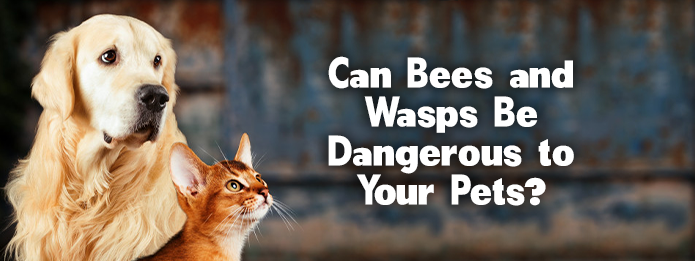Can Bees and Wasps Be Dangerous to Your Pets

When bees and wasps make themselves at home in human areas, homeowners often worry — with good reason — that they may develop severe symptoms if stung. Since people generally spend relatively little time outdoors, however, this risk is often relatively low. Family pets, however, tend to spend much more time outside, so it is natural to worry whether they are also at risk. Just like humans, pets react to insect stings with various degrees of swelling and anaphylaxis. Here is what to look for and what to do before calling pest control in Oakville.
Signs That Your Pet May Have Been Stung
When you have a beehive or wasp’s nest on your property, there is always a potential that your pet may be stung. Since not all stinging insects live in obvious hives, there is also a risk even when you haven’t noticed the presence of any in your yard or home. While it is perfectly possible for a sting to result in nothing more than a little discomfort, it is also possible for your pet to have a serious allergic reaction. For this reason, you should try to observe your pet periodically whenever they are outside, and especially when you let them inside.
When your pet comes in, cursorily look over their exposed areas, such as the nose, mouth and eyes. If you detect any swelling or redness, he or she may have been stung. Also, check for behavioural signs like limping or pawing at the face. If the culprit was an insect that leaves the stinger in its victim, the stinger will likely be lodged where the swelling is most pronounced. Try to remove it with a credit card or other object that won’t disturb the base that contains the venom. Watch your pet for several hours after a sting to look for signs of a serious reaction. In the meantime, you can wash the area gently and apply ice every 10 minutes or so.
Pets can sometimes aggravate stings or bites as they try to apply their own kind of first aid. If your pup or cat is pawing, biting or licking an area excessively, distract them with a chew toy. If they continue to disturb the area, you can use a type of pet cone.
Preventing Stings on Your Property
Of course, the best way to deal with stings is to prevent them before they happen. A simple way to do this is to peruse your property, looking for insects or signs of hive activity. If an area accessible to pets is clearly infested, do not allow your pet to go near. Block off the area immediately and notify everyone you live with. You should not attempt to remove a significant insect presence on your own, as you may be putting yourself at risk for an ineffective solution. A pest control professional knows how to determine the full extent of an infestation and can direct the removal process accordingly.
The Bee and Wasp Removal Process
When you call Truly Nolen, we arrive promptly to inspect your property. Once we have determined the full extent of your infestation and identified the species, we decide whether it is necessary to apply insecticide. In most indoor environments and transitional ones like porches, a treatment can completely eliminate nesting insects.
Having an infestation of stinging insects in or around your home can be worrying. Since pets are more likely to spend their time outside, they tend to be at higher risk for a sting. Because they usually don’t know to avoid certain insects, they can find themselves in danger relatively easily. If you have a bee or wasp infestation, call Truly Nolen. Our years of experience have made us the best pest control in Oakville.